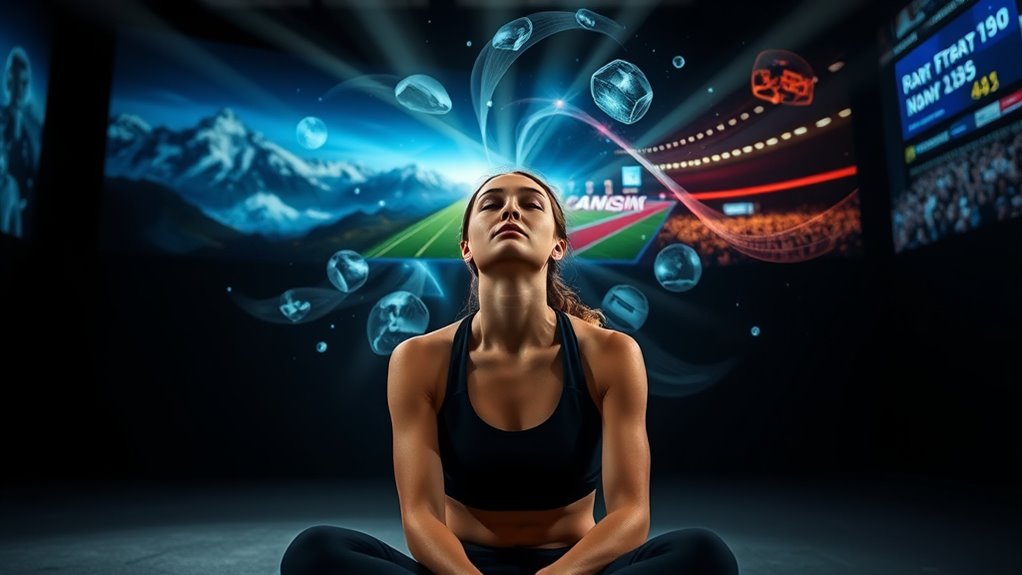Olympians use detailed visualization techniques by vividly imagining every aspect of their performance, from entering the arena to executing moves perfectly. They incorporate all senses, picturing sounds, sights, and feelings to make these images as real as possible. By regularly practicing goal-oriented mental rehearsal, you can boost confidence, reduce anxiety, and sharpen focus. Keep exploring how you can develop your own mental imagery skills to unleash peak performance.
Key Takeaways
- Olympians vividly imagine every detail of their performance, including sights, sounds, and sensations, to create realistic mental scenarios.
- They set specific goals for visualization, such as mastering techniques or maintaining focus, to guide their mental rehearsals.
- Regularly practicing visualization with sensory-rich imagery helps reinforce positive patterns and boosts confidence.
- Combining focused breathing and positive imagery enhances the effectiveness of mental rehearsal sessions.
- Consistent, deliberate visualization prepares both mind and body, reducing anxiety and improving overall performance.

Many Olympians rely on visualization techniques to enhance their performance and build confidence before competition. One of the most powerful methods they use is mental rehearsal, which involves vividly imagining every detail of their performance as if they’re experiencing it firsthand. When you practice mental rehearsal, you’re not just daydreaming—you’re actively engaging your mind to simulate the actual event. This process helps you familiarize yourself with the steps needed to succeed, reduces anxiety, and boosts your confidence. To effectively perform mental rehearsal, start by closing your eyes and creating a detailed mental image of your upcoming competition. Picture yourself walking into the arena, feeling the atmosphere, and executing your routine flawlessly. Focus on the sensory details: the sounds, the sights, even the smells. The more vivid and realistic your visualization, the more effective it becomes. Incorporating positive affirmations during your mental practice can further strengthen your self-belief and performance mindset.
Goal setting plays an essential role in this process. Olympians don’t just visualize winning; they set specific, achievable goals that guide their mental rehearsals. You should define clear objectives for each visualization session—whether it’s mastering a particular technique, maintaining focus under pressure, or executing a specific move perfectly. By establishing these goals, you give your mental rehearsals purpose and direction. For example, if you’re a runner, your goal might be to visualize maintaining a steady pace throughout the race, focusing on your breathing, stride, and mental resilience. As you progress, you can build upon these goals, making your mental rehearsals more detailed and tailored to your needs. This targeted approach helps you identify areas that need improvement and mentally prepare for different scenarios you might encounter.
To maximize the benefits, combine goal setting with mental rehearsal regularly. Dedicate time daily or several times a week to sit quietly, close your eyes, and run through your visualization. Use your goals as a checklist, ensuring your mental image includes all the key elements you want to improve. Over time, this will reinforce positive patterns, enhance your focus, and make your actual performance feel more natural. Remember, visualization isn’t just about wishful thinking; it’s a deliberate mental practice that primes your mind and body for success. By consistently setting goals and engaging in detailed mental rehearsal, you’ll develop the mental toughness and clarity that Olympians rely on when it matters most. Incorporating visualization techniques like controlled breathing and focusing on positive imagery can amplify these effects and further prepare you for peak performance.
Frequently Asked Questions
Can Visualization Improve Athletic Performance Without Physical Practice?
You might wonder if visualization can boost your athletic performance without physical practice. The answer is yes—mental rehearsal and sensory engagement help you imagine success vividly, strengthening neural pathways associated with skills. By visualizing your movements clearly and involving your senses, you can improve focus, confidence, and muscle memory. This mental approach complements physical training, making your practice more effective and helping you perform better when it counts.
How Long Should Each Visualization Session Last?
When considering your visualization sessions, focus on maintaining mental focus for ideal results. Usually, a session duration of 10 to 15 minutes works well, allowing you to stay engaged without mental fatigue. Longer sessions can diminish mental focus, so it’s best to keep them concise and consistent. Remember, quality outweighs quantity—short, focused sessions help you embed skills and boost confidence effectively.
Are There Specific Times of Day Best for Visualization?
Think of your mind as a garden; the timing strategies you choose can influence how well your visualization blooms. The best periods are typically morning or just before bed when your mind is calm and receptive. Research suggests these times maximize focus and retention. By aligning your visualization sessions with these ideal periods, you’re more likely to harness the full power of your mental rehearsal and improve your performance.
Can Visualization Techniques Be Used for Injury Recovery?
You can absolutely use visualization techniques for injury recovery. Mental imagery helps you picture the healing process, which can boost emotional regulation and reduce anxiety. By regularly imagining your body healing and returning to full strength, you activate your mind’s positive influence on recovery. This focused visualization can improve your motivation, lessen pain perception, and support your physical healing process, making it a valuable tool during injury rehabilitation.
Do All Olympians Use the Same Visualization Methods?
Imagine a sprinter mentally rehearsing her race, focusing on imagery clarity to perfect each move. Not all Olympians use the same visualization methods; they tailor mental rehearsal to their needs. Some emphasize vivid imagery to build confidence, while others focus on calming techniques. The key is consistency. You can adopt this approach by practicing mental rehearsal daily, enhancing imagery clarity, and customizing techniques to boost your performance.
Conclusion
Think of your mind as a powerful lighthouse, guiding you through the stormy seas of competition. Olympians harness visualization like a beacon, illuminating their path to success even in the darkest moments. By copying their techniques, you ignite your inner light, steering confidently toward your goals. Remember, just as a lighthouse never wavers, your mental imagery can keep you steady and focused, transforming dreams into reality with unwavering clarity and purpose.









